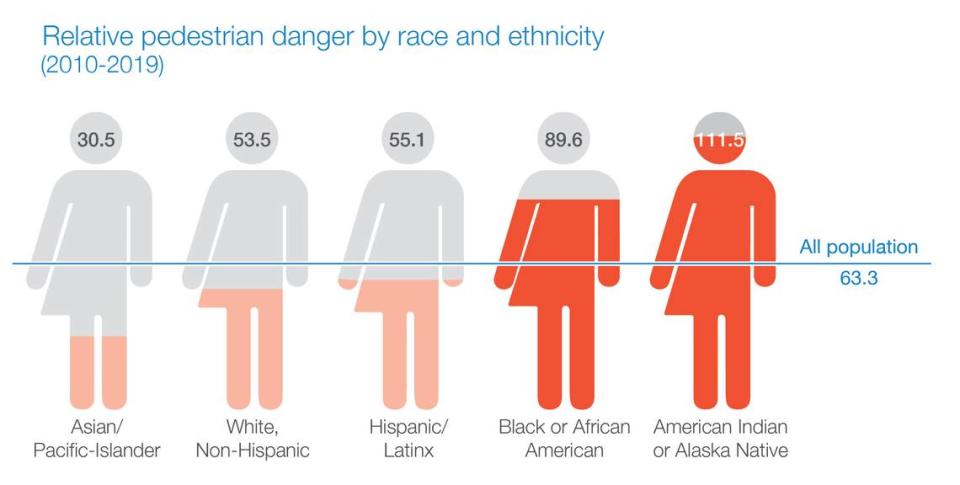Walking is hazardous to your health in Florida, the deadliest state for pedestrians
You take your life in your hands when you’re on foot in Florida, the deadliest state in the nation for pedestrians.
Walking can be hazardous to your health in the Sunshine State, which retained its notorious No. 1 ranking as the place where a pedestrian is most likely to be struck and killed by a driver in the United States, according to the 2021 “Dangerous By Design” report from Smart Growth America and the National Complete Streets Coalition.
Nine of the 15 most hazardous U.S. cities for pedestrians are in Florida, with Orlando ranked as least safe and the Miami-Fort Lauderdale-West Palm Beach metropolis ranked No. 13 in the biennial study released Tuesday.
Drivers hit and killed 53,435 pedestrians, more than 17 people per day on average, throughout the country between 2010 and 2019. The number of people killed while walking has been on a steady rise each year, growing by 45% over the most recent decade for which data was available for analysis.
“We continue to design and operate streets that prioritize the speedy movement of vehicles at the expense of safety for all people who use them,” the report says. “Many states and localities have spent the last 10 years focusing on enforcement, running ineffectual education campaigns, or blaming the victims of these crashes, while often ignoring the role of roadway design in these deaths. Meanwhile the death count has continued to climb year after year. This 10-year increase in deaths is a failure of our government at nearly all levels.”
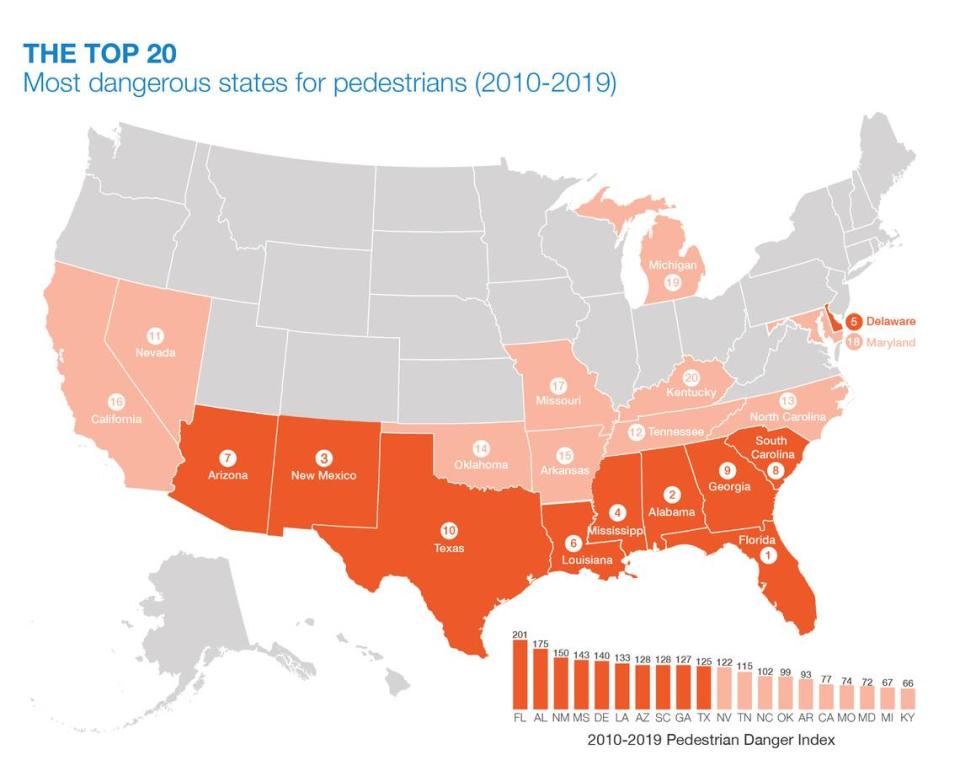
The report emphasized that fatality rates are disproportionately high for the elderly, Blacks, American Indian or Alaska Native people, and people walking in low-income communities. Black people were killed by drivers at a rate 82% higher than white people while people walking in poor neighborhoods were twice as likely to die as people in affluent neighborhoods.
“While transportation agencies have done much to avoid doing so, we urgently need to change the way we design and build roads to prioritize safety, not speed,” said Beth Osborne, transportation director for Smart Growth America. “In fact, the obsession with keeping traffic moving and avoiding delay at all costs in hopes of saving drivers mere seconds creates the very dangers highlighted in this report. This is why crosswalks are missing or too far apart, why lanes are too wide, why intersections are difficult to cross on foot, and why money can always be found to widen a road, even when adding sidewalks is deemed too expensive.”
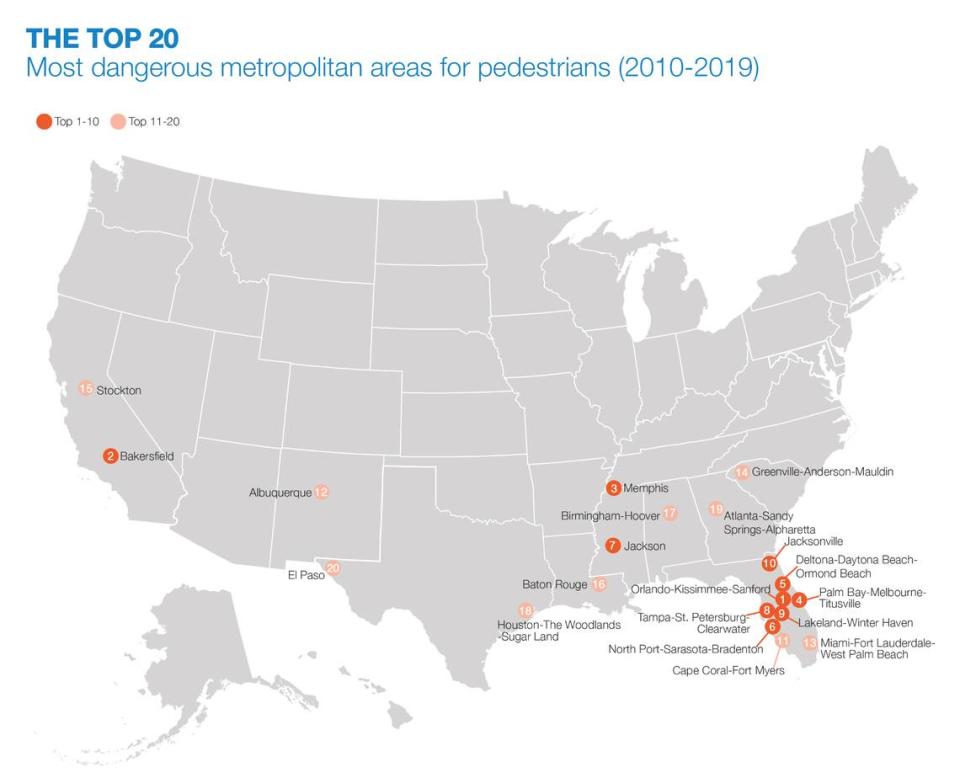
University of Florida junior Kailey Kiss urged the Florida Department of Transportation and local transportation agencies throughout her home state to heed the safety recommendations in the report. She was at a busy corner in Gainesville on Jan. 16 when she witnessed a car plow into a group of five students standing on a sidewalk, killing Sophia Lambert, an 18-year-old freshman from Miami. In December, Kiss’ Kappa Kappa Gamma sorority sister Maggie Paxton was killed in a hit-and-run near the same intersection, when she was crossing University Avenue.
“In one instant I saw Sophia hugging a friend and in the blink of an eye she was thrown into the air,” Kiss said. “I felt so helpless. But I’ve realized these crashes can be prevented. Cars drive way too fast on University Avenue because it’s designed for them to go 50 mph.
“I’m not surprised Florida is the worst state because we spend money building and expanding roads rather than investing in redesign of the dangerous ones.”
Compared to the skyrocketing fatality rate for pedestrians, traffic fatality rates for motor vehicle occupants have only increased 3.7% following a decline between 2008 and 2017. One reason it has become more dangerous to be a pedestrian is the growing popularity and size of SUVs and pickup trucks, which are two to three times more likely to kill a pedestrian in a crash than a sedan, according to a National Highway Traffic Safety Administration report.
In Florida, which was built for speed, there were 5,893 pedestrian deaths in the 10-year span, which is an annual average of 2.8 pedestrian deaths per 100,000 people, or a Pedestrian Danger Index (PDI) calculated in the report as 201.4. Compare that to the national figures of 1.6 average annual deaths per 100,000 and a 63.3 PDI. Compare Florida’s PDI to that of Texas (125.3), California (77.3), Ohio (44.1), New York (25.1) and the safest state, Vermont (15.2).
Orlando, at 740 deaths over the 10 years, recorded a frightening PDI of 295, with No. 2 Bakersfield, Calif., at 265 and No. 3 Memphis at 261. Melbourne-Titusville was No. 4 at 260.9 with Daytona Beach at No. 5 (260) and Sarasota-Bradenton at No. 6 (248) followed by Tampa-St. Petersburg, Lakeland, Jacksonville and Fort Myers taking the No. 8 through No. 11 spots.
In Miami-Fort Lauderdale-West Palm Beach, 1,675 pedestrians were hit and killed during the period for a PDI of 171.9. Compare Miami’s PDI to that of Houston (157.5), Atlanta (152.3), Los Angeles (85.4), Washington, D.C. (40.3), Chicago (39), San Francisco-Oakland (32.4), New York-Newark-Jersey City (28.3), Boston (19) and, safest of the 100 ranked most populous metro areas, Provo-Orem, Utah (14.8).
Florida’s dominance atop the list earned it a special section in the report, in which state leaders and the Florida Department of Transportation (FDOT) are chastised for failure to implement Complete Streets policies approved in 2014.
“Undoing the damage caused by decades spent building dangerous roads and car-scale development takes continuous and ongoing commitment,” the report says. “FDOT may have taken some important initial steps and clearly continues to have champions working to make streets safer, but the state has lost the momentum and political will needed to truly implement that change, and people walking continue to pay the price with their lives.”
Florida is not atypical in that its policies, blueprints and funding are stuck in the age of the automobile, when sprawling growth patterns — especially in Sun Belt states — led to wider roads and lanes, longer blocks, and street engineering that prioritized high speeds for cars over safety for people on foot, on bikes or using mass transit, said Steve Davis, director of communications for Smart Growth America.
“There is so much entrenched inertia in the practices and design manuals for traffic engineers that it is like trying to turn the Titanic,” Davis said. “Speed is the holy grail. Move as many cars through here as possible. Avoiding congestion is the goal, not making high-risk corridors safe for all users on the road. Unless FDOT makes significant changes in a calcified culture, cities can only do so much because so many roads are controlled by the state.”
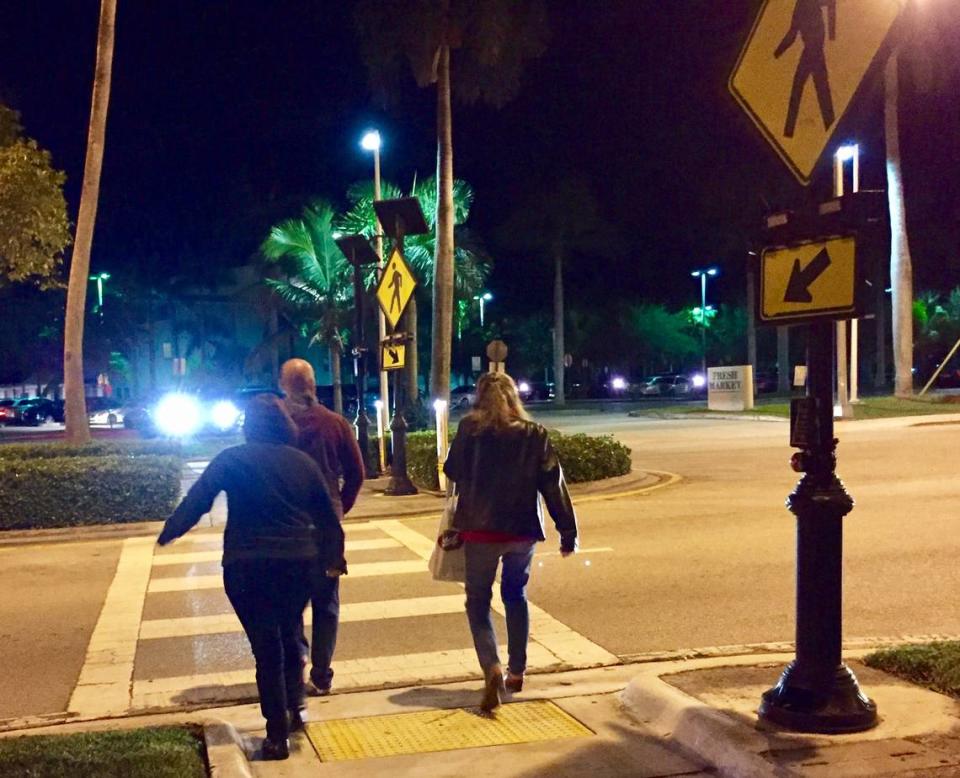
While the report covers 2010-2019 data, preliminary data on 2020 and the impacts of the coronavirus pandemic indicate that speeding increased dramatically in conjunction with a decrease in cars on the road and congestion. Although the U.S. Department of Transportation will not release 2020 fatality data until the end of 2021 at the earliest, the National Safety Council is already estimating a 24% spike in all traffic fatality rates in 2020 — the biggest increase in 96 years.
“We expect the number of deaths per mile traveled in 2020 will be crazy high,” Davis said. “Roads are even more dangerous when congestion decreases.”
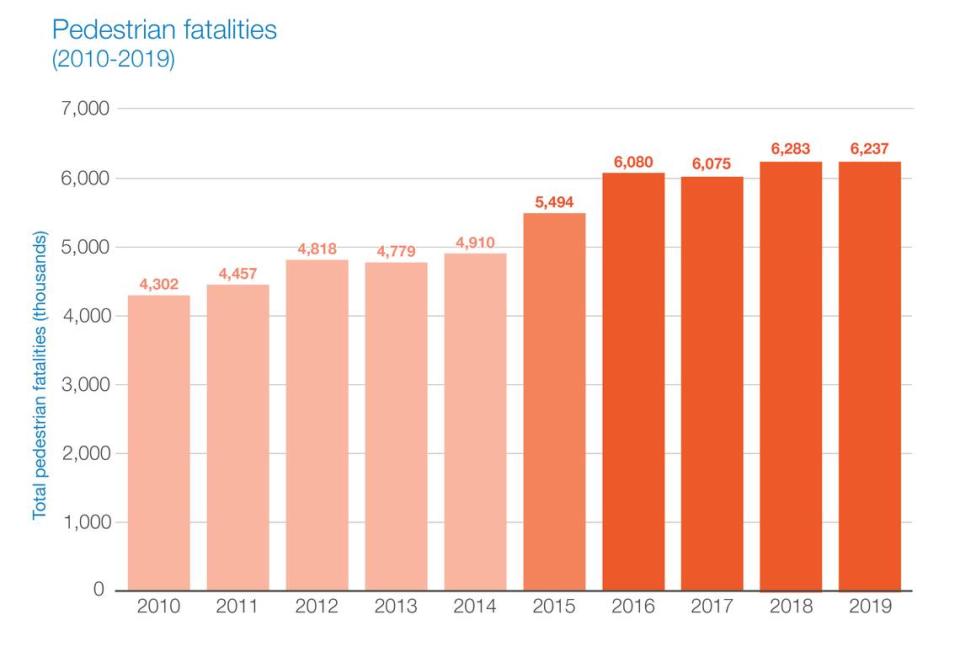
Smart Growth America, which advocates for more livable development, and the Complete Streets Coalition, which aims to transform the way roads are planned and built to accommodate all users, say the key to saving lives is designing safer streets with slower traffic, sensible intersections and more sidewalks and bike lanes. Current street design results in artificially high speed limits, and the likelihood of surviving a collision decreases rapidly as speeds increase past 30 mph.
The report urges Congress to pass the Complete Streets Act, which would require state and metro departments of transportation to plan for all people who use the street, including the most vulnerable. It suggests that agencies set targets to reduce injuries and fatalities and face penalties if they don’t meet them as well as provide updated training to planners.
Stop referring to pedestrian fatalities as accidents, the report says, “by replacing the word ‘accident’ with ‘crash’ when referring to these preventable deaths.”
